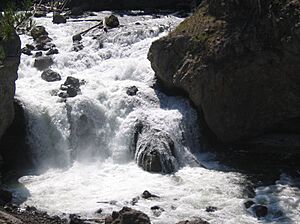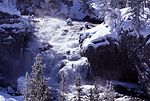Firehole Falls facts for kids
Quick facts for kids Firehole Falls |
|
|---|---|

Firehole Falls
|
|
| Lua error in Module:Infobox_mapframe at line 185: attempt to index field 'wikibase' (a nil value). | |
| Location | Yellowstone National Park, WY, US |
| Coordinates | 44°37′51″N 110°51′49″W / 44.63083°N 110.86361°W |
| Type | Cascade |
| Total height | 40 feet (12 m) |
| Number of drops | 1 |
| Watercourse | Firehole River |
Firehole Falls is a beautiful waterfall located in Yellowstone National Park. You can find it in the southwestern part of the park, in the state of Wyoming in the United States. This amazing waterfall is on the Firehole River.
The falls are about 40 feet (12 meters) tall. They are located inside a place called Firehole Canyon. You can visit them by driving on Firehole Canyon Drive. This is a special one-way road that runs next to the main road. It connects Madison Junction to the famous Old Faithful area.
Exploring Firehole Falls History
In 1871, a U.S. Army officer named Lt. Gustavus Cheyney Doane described the falls. He was part of an early exploration group called the Washburn–Langford–Doane Expedition. He wrote about following the river through a deep canyon. He mentioned the rapids and the 40-foot drop.
Even though explorers saw and wrote about the falls, no one knows exactly how they got their name. By the mid-1880s, people commonly called them Firehole Falls. This name was used in official park documents and travel guides.
Fish and the Falls: A Natural Barrier
When the first explorers visited the Firehole River in 1870, there were no fish living above Firehole Falls. The waterfall acted like a natural wall. It stopped fish from swimming upstream from the Madison River. The upper Firehole River was cut off from other water systems.
But things changed later on! In 1889, people brought the first brook trout to the river above the falls. Then, in 1890, brown trout were introduced into a nearby stream called Nez Perce Creek. In the 1920s, rainbow trout were also added to the river.
Today, Firehole Falls still stops fish from swimming upstream to lay their eggs. However, because of these fish introductions, the upper Firehole River has become a fantastic place for trout fishing. It's known as a "world-class" spot for catching trout!


